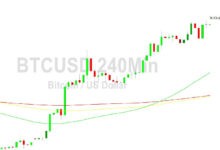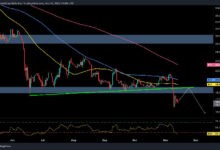Bitcoin Holds Strong Over $23.6K to Continue Recent Consolidation

Bitcoin edged toward $24,000 early Wednesday, dropped, but then rebounded to hold strong above $23,600.
The largest cryptocurrency by market capitalization was recently trading at about $23,663, up 2.3% over the past 24 hours.
Bitcoin (BTC)’s failure to regain the $25,000 threshold it surpassed in mid-February and recent consolidation “could be a sign of weakness, at least in the short-term,” Craig Erlam, senior market analyst at foreign exchange market maker Oanda, wrote in a Wednesday note.
Ether (ETH), the second-largest cryptocurrency, recently jumped more than 4% to recently trade around $1,665. The CoinDesk Market Index that measures crypto market performance was up around 2.9% for the day.
Decentralized finance (DeFi) lending and borrowing platform Maker’s native MKR token saw a nearly 19% surge over the past 24 hours. Data from CoinGlass showed that traders who bet on price shifts liquidated more than $444,000 of MKR short positions in the past 24 hours. That was more than 16 times the $27,000 of MKR long positions that investors liquidated over the same period. These types of short squeezes have historically tended to accelerate price jumps.
In a tweet last week, blockchain analytics firm Santiment noted the largest whale moves involving MKR in three months with more than 24,000 of the tokens worth around $17.4 million at the time “moved to a whale address” and a subsequent identically sized move. Santiment viewed the moves as bullish.
“On downswings, massive moves like this are often correlated with turnarounds,» Santiment wrote.
Meanwhile, traditional markets turned mixed on Wednesday as the S&P 500 and the tech-heavy Nasdaq Composite recently slid 0.4% and 0.6%, respectively. The Dow Jones Industrial Average (DJIA) was up 0.02%.
In the aftermath of several disappointing indicators suggesting that inflation remains problematic, investors increasingly expect the U.S. central bank to continue raising interest rates in upcoming months, although a fourth consecutive monthly contraction in the Institute of Supply Management (ISM) Manufacturing PMI data offered some evidence of an economic slowdown.
Macroeconomic concerns pushed the 10-year Treasury yield to over 4% Wednesday – the first time since last November.
“We want prices to rise at a much slower rate than they are now, so disinflation will need to occur for that to happen,” Steve Sosnick, chief strategist at brokerage firm Interactive Brokers, wrote in a Wednesday note, referencing Fed Chair Jerome Powell’s repeated use the term of “disinflation” in February.
“We should all welcome the time when disinflation becomes a lasting feature of our economy,” Sosnick continued. “But for now, the disinflation that we might have seen late last year appears to have been transitory.”






 Bitcoin
Bitcoin  Ethereum
Ethereum  Tether
Tether  USDC
USDC  Dogecoin
Dogecoin  TRON
TRON  Cardano
Cardano  Chainlink
Chainlink  LEO Token
LEO Token  Bitcoin Cash
Bitcoin Cash  Stellar
Stellar  Hedera
Hedera  Litecoin
Litecoin  Monero
Monero  Dai
Dai  OKB
OKB  Cronos
Cronos  Ethereum Classic
Ethereum Classic  Gate
Gate  VeChain
VeChain  Cosmos Hub
Cosmos Hub  Algorand
Algorand  KuCoin
KuCoin  Stacks
Stacks  Tether Gold
Tether Gold  Zcash
Zcash  Theta Network
Theta Network  IOTA
IOTA  Tezos
Tezos  TrueUSD
TrueUSD  NEO
NEO  Polygon
Polygon  Ravencoin
Ravencoin  Dash
Dash  Decred
Decred  Zilliqa
Zilliqa  Qtum
Qtum  Synthetix Network
Synthetix Network  0x Protocol
0x Protocol  Basic Attention
Basic Attention  Siacoin
Siacoin  Holo
Holo  DigiByte
DigiByte  Nano
Nano  Enjin Coin
Enjin Coin  Ontology
Ontology  Status
Status  Hive
Hive  Waves
Waves  Lisk
Lisk  Pax Dollar
Pax Dollar  Steem
Steem  Numeraire
Numeraire  BUSD
BUSD  NEM
NEM  Huobi
Huobi  OMG Network
OMG Network  Bitcoin Gold
Bitcoin Gold  Ren
Ren  Bitcoin Diamond
Bitcoin Diamond  Augur
Augur  HUSD
HUSD  Energi
Energi